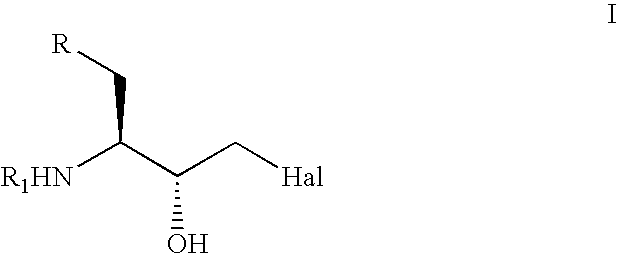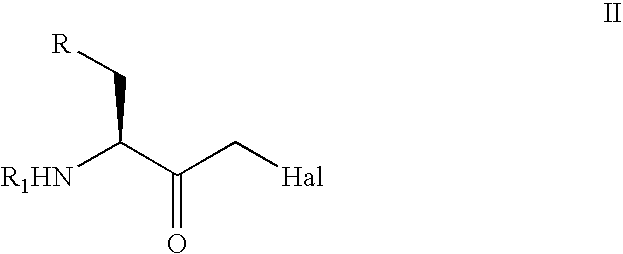Stereoselective reduction of substituted oxo-butanes
a technology of oxobutanes and oxobutanes, which is applied in the field of stereoselective reduction of substituted oxobutanes, can solve the problems of difficult prediction of absolute configuration of products or, in particular, the likely excess of enantiomerics, and achieve excellent diastereomeric purity and high yield
- Summary
- Abstract
- Description
- Claims
- Application Information
AI Technical Summary
Benefits of technology
Problems solved by technology
Method used
Image
Examples
example 1
Stereoselective Enzymatic Reduction: Use of Whole Cells—Single Stage Process
[0042]Rhodococcus erythropolis ATCC 4277 cells (1 mL) was inoculated into 100 mL of Medium 1 as noted above in a 500 mL flask and incubated at 28° C. and 200 RPM on a shaker for 22 hours. The pH of 50 cells broth was adjusted to pH 7.0 with 1 M potassium phosphate buffer. Glucose was added to the cell broth at 25 mg / mL and 50 mg. of (1S)-[N-(1-benzyl-2-oxo-3-chloro)propyl]carbamic acid t-butyl ester (the substrate) was added thereto. The biotransformations (reductions) were carried out at 28° C. and 200 RPM on a shaker. At predetermined times the reaction mixtures were quenched with two volumes of a 60:40 mixture of t-butyl methyl ether and toluene, and the separated organic phase was filtered through a 0.2 micron filter and collected. Two mL of the organic phase was evaporated to dryness under a stream of nitrogen and the residue taken up with 1 mL of acetonitrile, filtered and analyzed by HPLC for (1S,2R)-...
example 2
Use of Whole Cells: Two Stage Process
[0044]The substrate and the product for this Example were as described in Example 1. Cells of Rhodococcus erythropolis ATCC 4277 and Rhodococcus erythropolis DSM 6971 (1 mL) were individually inoculated into 100 mL portions of Medium 1 as noted above in a 500 mL flask and incubated at 25° C. and 280 RPM on a shaker for 48 hours. One hundred m.L of each culture was innoculated into 15 mL of Medium 1 combined in a fermentor. Growth in the fermentor was carried out at 25° C., 15 LPM (liters per minute) aeration and 500 RPM agitation for 36 hours. Cells were harvested from the fermentor and used for the enzymatic conversion (biotransformation) of (1S)-[N-(1-benzyl-2-oxo-3-chloro)propyl]carbamic acid t-butyl ester (the substrate) to (1S,2R)-[N-(1-benzyl-2-hydroxy-3-chloro)propyl]carbamic acid t-butyl ester (the product). Cell suspensions were prepared by suspending the cells, 20 grams in 100 mL of 64 mM potassium phosphate buffer, pH 7.0. To each susp...
example 3
Use of Various Microbial Strains for Biotransformation: Whole Cells
[0046]A series of microorganisms was utilized to carry out the biotransformation according to the process of Example 1. The results are shown in Table 3.
[0047]
TABLE 3SubstrateDiaster-InputYieldeomericMicroorganismCulture ID(mg / mL)(%)Purity (%)AgrobacteriumATCC 33970125.475.8Brevibacterium sp.ATCC 19653210093.9Hansenula anomalaATCC 8170131.876.2Hansenula anomalaATCC 58044133.1>98Hansenula polymorphaATCC 34438137.679.2Hansenula polymorphaATCC 2601216.1>98Hansenula saturnusATCC 16762135.1>98Pseudomonas cepaciaATCC 2935115.2—Pseudomonas speciesATCC 20202715.1—RhodococcusATCC 4277274.2>98RhodococcusATCC 27854277.7>98RhodococcusATCC 25544261.1>98RhodococcusDSM 69712100>98RhodococcusDSM 6977272.8>98Rhodococcus marisATCC 35013216.6>98RhodococcusATCC 14347266.261.9RhodococcusATCC 21197214.0—Rhodococcus speciesATCC 15592291.2>98Rhodococcus speciesATCC 29673232.5>98Rhodococcus speciesATCC 212272100>98Rhodococcus speciesATCC 211...
PUM
 Login to View More
Login to View More Abstract
Description
Claims
Application Information
 Login to View More
Login to View More - R&D
- Intellectual Property
- Life Sciences
- Materials
- Tech Scout
- Unparalleled Data Quality
- Higher Quality Content
- 60% Fewer Hallucinations
Browse by: Latest US Patents, China's latest patents, Technical Efficacy Thesaurus, Application Domain, Technology Topic, Popular Technical Reports.
© 2025 PatSnap. All rights reserved.Legal|Privacy policy|Modern Slavery Act Transparency Statement|Sitemap|About US| Contact US: help@patsnap.com



